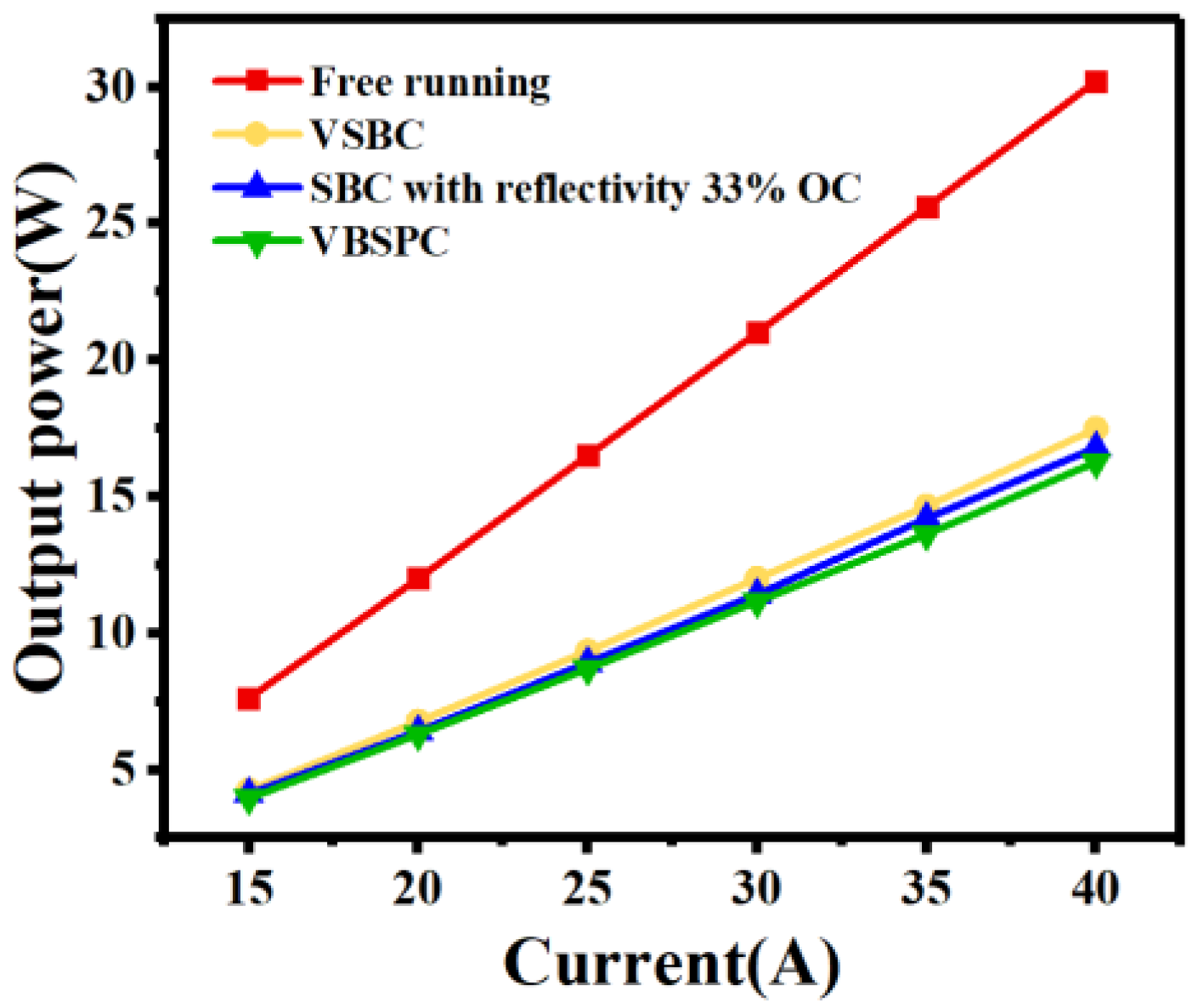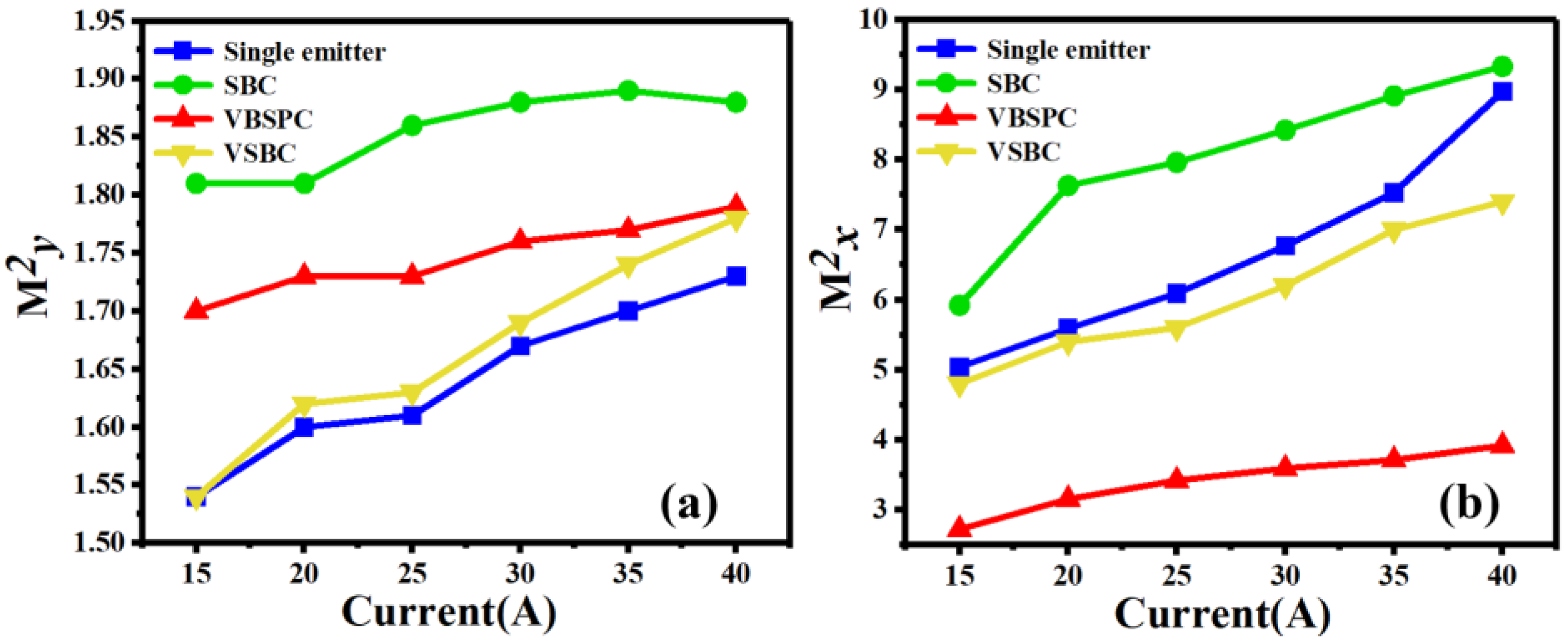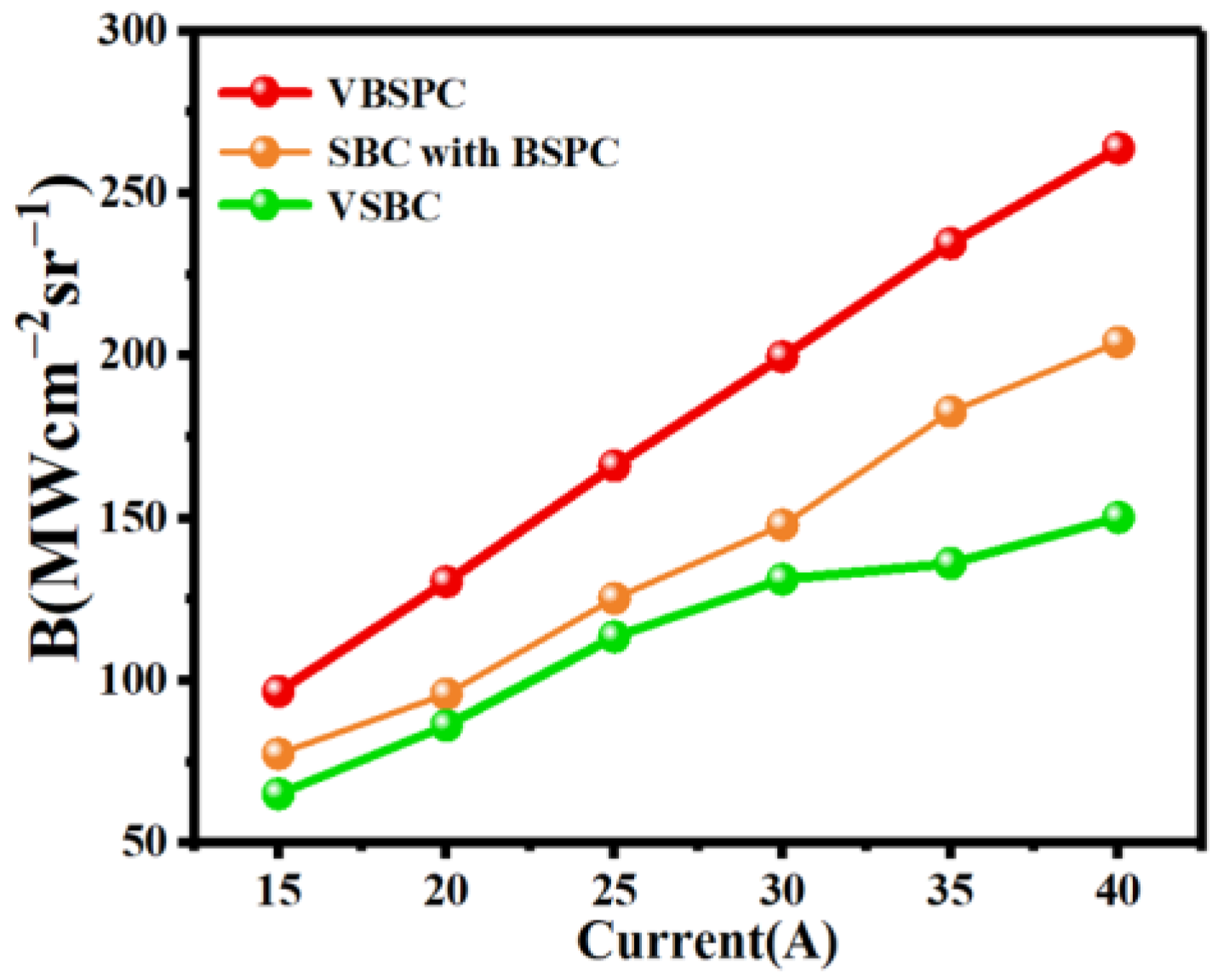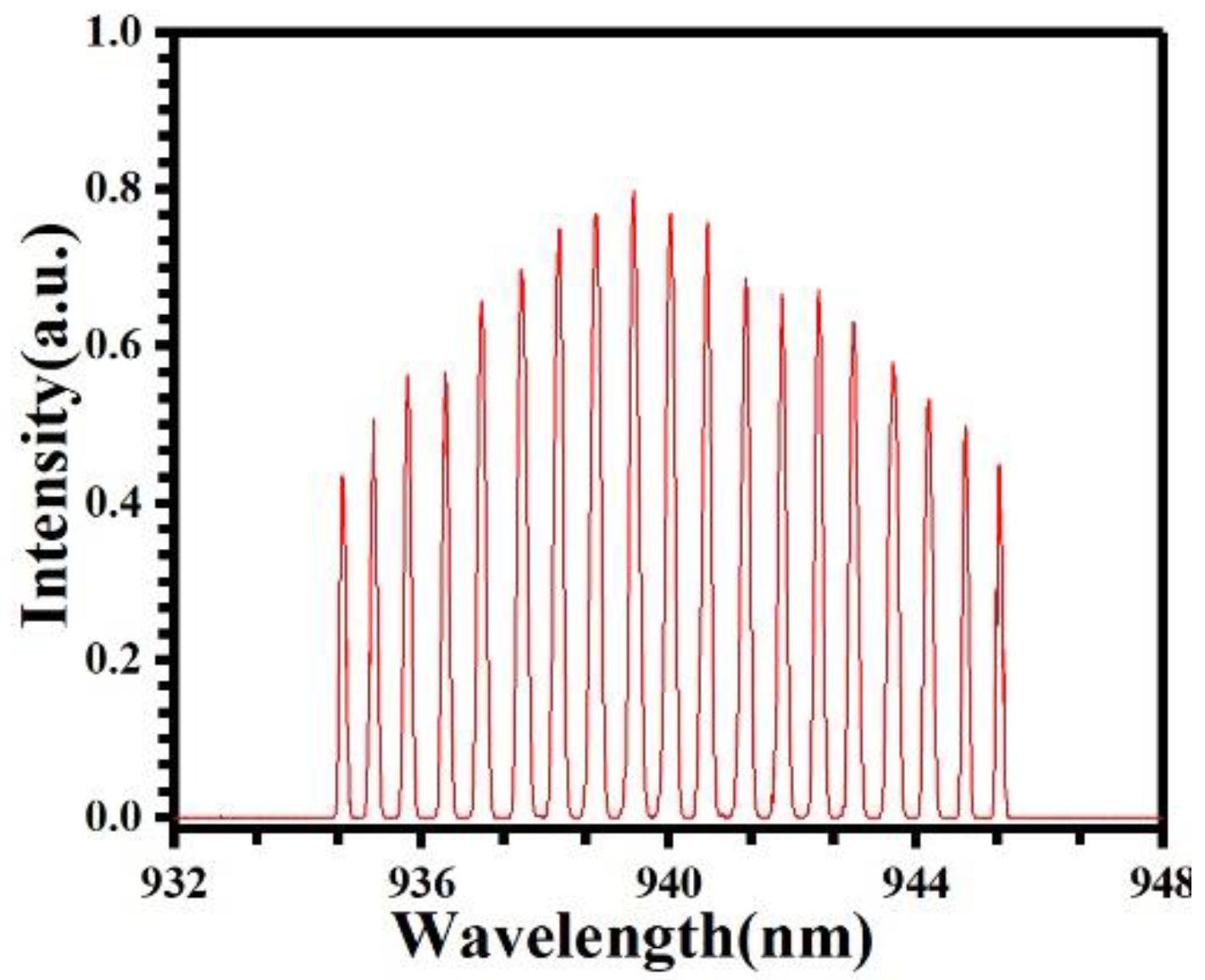High Brightness Diode Laser Based on V-Shaped External Cavity and Beam-Waist Splitting Polarization Combining
Abstract
:1. Introduction
2. Materials and Methods
3. Results
4. Discussion
5. Patents
Author Contributions
Funding
Institutional Review Board Statement
Informed Consent Statement
Data Availability Statement
Conflicts of Interest
References
- Yu, H.; Tan, S.; Pan, H. High-brightness fiber-coupled diode module using dense wavelength beam combining technology based on single emitter for material processing and fiber amplifier pumping. Proc. SPIE 2022, 11983, 72–78. [Google Scholar] [CrossRef]
- Eyal, S.; Yaniv, V.; Benayahu, U. 16kW single mode CW laser with dynamic beam for material processing. Proc. SPIE 2020, 11260, 267–272. [Google Scholar] [CrossRef]
- Strohmaier, S.G.; Erbert, G.; Meissner-Schenk, A.H. kW-class diode laser bars. Proc. SPIE 2017, 10086, 77–82. [Google Scholar] [CrossRef]
- Daming, L.; Serge, C.; Xu, J. Power scaling of mini-bar-based high-power 780–980 nm pump modules at Spectra Physics. Proc. SPIE 2009, 7198, 453–458. [Google Scholar] [CrossRef]
- Wang, L.; Qu, H.; Qi, A. High-power laser diode at 9xx nm with 81.10% efficiency. Opt. Lett. 2022, 47, 3231–3234. [Google Scholar] [CrossRef]
- Sakaev, I.; Ishaaya, A.A. Diode laser assisted oxygen cutting of thick mild steel with off-axis beam delivery. Opt. Laser Technol. 2021, 138, 106876. [Google Scholar] [CrossRef]
- Polat, B.; Ozay, Y.; Kucukkara, I.; Dizge, N. A new method for membrane manufacturing from polyamide with semiconductor diode laser. J. Mem. Sci. 2022, 641, 119807. [Google Scholar] [CrossRef]
- Yihan, X.; Ching-long, J.; Ayesha, J. Advances in 976 nm single emitter broad area semiconductor diode lasers for 300W+ fiber laser pump module applications. Proc. SPIE 2022, 641, 119807. [Google Scholar] [CrossRef]
- Talla Mbé, J.H.; Woafo, P. Modulation of distributed feedback (DFB) laser diode with the autonomous Chua’s circuit: Theory and experiment. Opt. Laser Technol. 2018, 100, 145–152. [Google Scholar] [CrossRef]
- Patil, D. Semiconductor Laser Diode Technology and Applications; Books on Demand: Norderstedt, Germany, 2012; Chapter 5. [Google Scholar]
- Tünnermann, H.; Pöld, J.H.; Neumann, J. Beam quality and noise properties of coherently combined ytterbium doped single frequency fiber amplifiers. Opt. Express 2011, 1920, 19600–19606. [Google Scholar] [CrossRef]
- Yu, C.X.; Augst, S.J.; Redmond, S. Coherent combining of a 4 kW, eight-element fiber amplifier array. Opt. Lett. 2011, 3614, 2686–2688. [Google Scholar] [CrossRef]
- Redmond, S.M.; Ripin, D.J.; Charles, X.Y. Diffractive coherent combining of a 2.5 kW fiber laser array into a 1.9 kW Gaussian beam. Opt. Lett. 2012, 3714, 2832–2834. [Google Scholar] [CrossRef]
- Yang, G.; Liu, L.; Jiang, Z. Incoherent beam combining based on the momentum SPGD algorithm. Opt. Laser Technol. 2018, 101, 372–378. [Google Scholar] [CrossRef]
- Daneu, V.; Sanchez, A.; Fan, T.Y. Spectral beam combining of a broad-stripe diode laser array in an external cavity. Opt. Lett. 2000, 256, 405–407. [Google Scholar] [CrossRef]
- Cook, C.C.; Fan, T.Y. Spectral beam combining of Yb-doped fiber lasers in an external cavity. In Advanced Solid State Lasers; Optica Publishing Group: Washington, DC, USA, 1999; p. PD5. [Google Scholar]
- Huang, R.K.; Chann, B.; Missaggia, L.J. High-brightness wavelength beam combined semiconductor laser diode arrays. IEEE Photon-Technol. Lett. 2007, 194, 209–211. [Google Scholar] [CrossRef]
- Zhang, J.; Peng, H.; Liu, Y. Hundred-watt diode laser source by spectral beam combining. Laser Phys. Lett. 2014, 1112, 125803. [Google Scholar] [CrossRef]
- Meng, H.; Sun, T. High-brightness spectral beam combining of diode laser array stack in an external cavity. Opt. Express 2015, 2317, 21819–21824. [Google Scholar] [CrossRef]
- Zheng, Y.; Yang, Y.; Wang, J. 10.8 kW spectral beam combination of eight all-fiber super fluorescent sources and their dispersion compensation. Opt. Express 2016, 2411, 12063–12071. [Google Scholar] [CrossRef]
- Lin, X.; Lin, G.; Zhao, P. Generation of high brightness diode laser by using spectral and polarization beam combination. Opt. Laser Technol. 2019, 116, 219–223. [Google Scholar] [CrossRef]
- Huang, R.K.; Samson, B.; Chann, B.; Lochman, B.; Tayebati, P. Recent progress on high-brightness kW-class direct diode lasers. In Proceedings of the 2015 IEEE High Power Diode Lasers and Systems Conference (HPD), Coventry, UK, 14–15 October 2015. [Google Scholar]
- Platz, R.; Erbert, G.; Pittroff, W.; Malchus, M.; Vogel, K.; Tränkle, G. 400 μm stripe lasers for high-power fiber coupled pump modules. High Power Laser Sci. Eng. 2013, 1, 60–67. [Google Scholar] [CrossRef] [Green Version]
- Su, J.; Tong, C.; Wang, L.; Wang, Y.; Lu, H.; Zhao, Z.; Wang, J.; Tan, S.; Shu, S.; Wang, L. Beam waist shrinkage of high-power broad-area diode lasers by mode tailoring. Opt. Express 2020, 28, 13131–13140. [Google Scholar] [CrossRef] [PubMed]
- Wang, L.; Tong, C.; Shu, S.; Tian, S.; Sun, F.; Zhao, Y.; Lu, H.; Zhang, X.; Hou, G.; Wang, L. Loss tailoring of high-power broad-area diode lasers. Opt. Lett. 2019, 44, 3562–3565. [Google Scholar] [CrossRef] [PubMed]
- Vijayakumar, D.; Jensen, O.B.; Ostendorf, R. Spectral beam combining of a 980 nm tapered diode laser bar. Opt. Express 2010, 182, 893–898. [Google Scholar] [CrossRef] [PubMed]
- Müller, A.; Vijayakumar, D.; Jensen, O.B.; Hasler, K.-H.; Sumpf, B.; Erbert, G.; Andersen, P.E.; Petersen, P.M. 16 W output power by high-efficient spectral beam combining of DBR-tapered diode lasers. Opt. Express 2011, 192, 1228–1235. [Google Scholar] [CrossRef] [PubMed]
- Chann, B.; Huang, R.K.; Missaggia, L.J.; Harris, C.T.; Liau, Z.L.; Goyal, A.K.; Donnelly, J.P.; Fan, T.Y.; Sanchez-Rubio, A.; Turner, G.W. Near-diffraction-limited diode laser arrays by wavelength beam combining. Opt. Lett. 2005, 3016, 2104–2106. [Google Scholar] [CrossRef]
- Jensen, O.B.; Thestrup, B.; Andersen, P.E. Near-diffraction-limited segmented broad area diode laser based on off-axis spectral beam combining. App. Phy. B 2006, 832, 225–228. [Google Scholar] [CrossRef]
- Vijayakumar, D.; Jensen, O.B.; Thestrup, B. 980 nm high brightness external cavity broad area diode laser bar. Opt. Express 2009, 177, 5684–5690. [Google Scholar] [CrossRef]
- Sun, F.; Shu, S.; Zhao, Y. High-brightness diode lasers obtained via off-axis spectral beam combining with selective feedback. Opt. Express 2018, 2617, 21813–21818. [Google Scholar] [CrossRef]
- Jechow, A.; Raab, V. High cw power using an external cavity for spectral beam combining of diode laser-bar emission. Appl. Opt. 2006, 4515, 3545–3547. [Google Scholar] [CrossRef]
- Zhao, Y.; Sun, F.; Tong, C. Going beyond the beam quality limit of spectral beam combining of diode lasers in a V-shaped external cavity. Opt. Express 2018, 2611, 14058–14065. [Google Scholar] [CrossRef]
- Zhao, Y.; Tong, C.; Wang, L.; Wang, Y.; Lu, H.; Zhang, X.; Wei, Z.; Wang, L. High Brightness Diode Lasers Based on Beam Splitting and Polarization Combining. App. Sci. 2022, 1216, 7980. [Google Scholar] [CrossRef]
- Witte, U.; Schneider, F.; Traub, M.; Hoffmann, D.; Drovs, S.; Brand, T.; Unger, A. kW-class direct diode laser for sheet metal cutting based on DWDM of pump modules by use of ultra-steep dielectric filters. Opt. Express 2016, 24, 22917–22929. [Google Scholar] [CrossRef] [PubMed]
- Zhu, Z.; Gou, L.; Jiang, M.; Hui, Y.; Lei, H.; Li, Q. High beam quality in two directions and high efficiency output of a diode laser array by spectral-beam-combining. Opt. Express 2014, 22, 17804–17809. [Google Scholar] [CrossRef]
- Winterfeldt, M.; Crump, P.; Knigge, S. High beam quality in broad area lasers via suppression of lateral carrier accumulation. IEEE Photon-Technol. Lett. 2015, 2717, 1809–1812. [Google Scholar] [CrossRef]






| Parameters | Value |
|---|---|
| Wavelength/nm | 940 |
| Chip width/mm | 10 |
| Cavity length/mm | 1.5 |
| Number of emitters | 19 |
| Emitter pitch/μm | 500 |
| Emitter width/μm | 100 |
| Cavity length/mm | 1.5 |
| The thickness of the waveguide/μm | 1 |
| θfast 95%power content/(°) | 45 |
| θslow 95%power content/(°) | 7 |
| Polarization | TE |
Disclaimer/Publisher’s Note: The statements, opinions and data contained in all publications are solely those of the individual author(s) and contributor(s) and not of MDPI and/or the editor(s). MDPI and/or the editor(s) disclaim responsibility for any injury to people or property resulting from any ideas, methods, instructions or products referred to in the content. |
© 2023 by the authors. Licensee MDPI, Basel, Switzerland. This article is an open access article distributed under the terms and conditions of the Creative Commons Attribution (CC BY) license (https://creativecommons.org/licenses/by/4.0/).
Share and Cite
Zhao, Y.; Tong, C.; Wei, Z.; Feng, J.; Wang, L. High Brightness Diode Laser Based on V-Shaped External Cavity and Beam-Waist Splitting Polarization Combining. Appl. Sci. 2023, 13, 2125. https://doi.org/10.3390/app13042125
Zhao Y, Tong C, Wei Z, Feng J, Wang L. High Brightness Diode Laser Based on V-Shaped External Cavity and Beam-Waist Splitting Polarization Combining. Applied Sciences. 2023; 13(4):2125. https://doi.org/10.3390/app13042125
Chicago/Turabian StyleZhao, Yufei, Cunzhu Tong, Zhipeng Wei, Jian Feng, and Lijie Wang. 2023. "High Brightness Diode Laser Based on V-Shaped External Cavity and Beam-Waist Splitting Polarization Combining" Applied Sciences 13, no. 4: 2125. https://doi.org/10.3390/app13042125





